Performance Evaluation of UF Membranes Derived from Recycled RO Membrane, a Step towards Circular Economy in Desalination
Abstract
1. Introduction
2. Material and Methods
2.1. RO Pilot Plant Description
2.2. Operational Details and Parameters
2.3. Conversion Procedure
2.4. Characteristics of Water
2.5. Membrane Characterization
Scanning Electron Microscopy (SEM) Analysis
3. Results and Discussion
3.1. RO to R-RO (Degradation of Polyamide PA Layer)
3.2. R-RO Permeate Flux and TMP
3.3. SEM Analysis of R-RO Membrane
3.4. Physicochemical and Microbial Parameters
3.5. Turbidity Removal %
3.6. Total Coliforms Removal %
4. Conclusions
- Conversion of R-RO using the same concentration of NaOCl for 10 h depicted no variation in the results, and pH also remained constant.
- R-RO membranes proved to be very effective on TW, ICW-P, and MBR-P in terms of water recovery % that can be compared with the virgin UF spiral wound membrane.
- It also demonstrated an unprecedented turbidity removal percentage of 95% which is exactly equal to UF performance in some studies in the literature.
- The COD removal percentage was observed to be up to 67% using the R-RO membrane, which is in accordance with converted RO membranes in the literature.
- The highest number of total coliforms were present in all of the feed water from (TW, ICW-P, and MBR-P), but R-RO ensured it was safe for use by eliminating all of the total coliforms with a 95% confidence level.
- It proved to be an economically viable, environmentally friendly, and sustainable approach to convert the RO-used membranes and utilize them for water treatment of these origins because its product water is under the drinking water limits for TW and effluent discharge limits for ICW-P and MBR-P of the WHO and Pakistan’s NSDWQ (National Standards for Drinking Water Quality) and NEQS (National Environmental Quality Standards), respectively.
- Developing countries can leverage this by importing the used RO membrane from the developed nations and play a pivotal role in the reduction of waste and transition towards the circular economy.
Supplementary Materials
Author Contributions
Funding
Data Availability Statement
Conflicts of Interest
References
- Angelakis, A.N.; Valipour, M.; Choo, K.-H.; Ahmed, A.T.; Baba, A.; Kumar, R.; Toor, G.S.; Wang, Z. Desalination: From ancient to present and future. Water 2021, 13, 2222. [Google Scholar] [CrossRef]
- Drinan, J.E.; Spellman, F. Water and Wastewater Treatment: A Guide for the Nonengineering Professional; CRC Press: Boca Raton, FL, USA, 2012. [Google Scholar]
- Greenlee, L.F.; Lawler, D.F.; Freeman, B.D.; Marrot, B.; Moulin, P. Reverse osmosis desalination: Water sources, technology, and today’s challenges. Water Res. 2009, 43, 2317–2348. [Google Scholar] [CrossRef] [PubMed]
- Jokinen, L. Optimising Flocculation and Cell Separation of Fermentation Broth with In-Situ Particle Size Analysis; Turku University of Applied Sciences: Turku, Finland, 2022. [Google Scholar]
- Kumar, M.; Culp, T.; Shen, Y. Water Desalination: History, Advances, and Challenges. In Frontiers of Engineering Report on Leading-Edge Engineering; The National Academy Press Pennsylvania State University: Philadelphia, PA, USA, 2017. [Google Scholar]
- Goh, P.; Ismail, A.; Hilal, N. Nano-enabled membranes technology: Sustainable and revolutionary solutions for membrane desalination? Desalination 2016, 380, 100–104. [Google Scholar] [CrossRef]
- Malaeb, L.; Ayoub, G.M. Reverse osmosis technology for water treatment: State of the art review. Desalination 2011, 267, 1–8. [Google Scholar] [CrossRef]
- Joo, S.H.; Tansel, B. Novel technologies for reverse osmosis concentrate treatment: A review. J. Environ. Manag. 2015, 150, 322–335. [Google Scholar] [CrossRef]
- Najafi, F.T.; Alsaffar, M.; Schwerer, S.C.; Brown, N.; Ouedraogo, J. Environmental impact cost analysis of multi-stage flash, multi-effect distillation, mechanical vapor compression, and reverse osmosis medium-size desalination facilities. In Proceedings of the 2016 ASEE Annual Conference & Exposition, New Orleans, LA, USA, 26 June–28 August 2016. [Google Scholar]
- Fang, W.; Shi, L.; Wang, R. Interfacially polymerized composite nanofiltration hollow fiber membranes for low-pressure water softening. J. Membr. Sci. 2013, 430, 129–139. [Google Scholar] [CrossRef]
- Landaburu-Aguirre, J.; García-Pacheco, R.; Molina, S.; Rodríguez-Sáez, L.; Rabadán, J.; García-Calvo, E. Fouling prevention, preparing for re-use and membrane recycling. Towards circular economy in RO desalination. Desalination 2016, 393, 16–30. [Google Scholar] [CrossRef]
- Ismail, A.; Padaki, M.; Hilal, N.; Matsuura, T.; Lau, W. Thin film composite membrane—Recent development and future potential. Desalination 2015, 356, 140–148. [Google Scholar] [CrossRef]
- Camilleri, M.A. Closing the loop for resource efficiency, sustainable consumption and production: A critical review of the circular economy. Int. J. Sustain. Dev. 2018, 21, 1–17. [Google Scholar] [CrossRef]
- McCarthy, A.; Dellink, R.; Bibas, R. The Macroeconomics of the Circular Economy Transition: A Critical Review of Modelling Approaches; OECD Publishing: Paris, France, 2018. [Google Scholar]
- Goyal, S.; Esposito, M.; Kapoor, A. Circular economy business models in developing economies: Lessons from India on reduce, recycle, and reuse paradigms. Thunderbird Int. Bus. Rev. 2018, 60, 729–740. [Google Scholar] [CrossRef]
- Senan-Salinas, J.; Blanco, A.; Garcia-Pacheco, R.; Landaburu-Aguirre, J.; García-Calvo, E. Prospective Life Cycle Assessment and economic analysis of direct recycling of end-of-life reverse osmosis membranes based on Geographic Information Systems. J. Clean. Prod. 2021, 282, 124400. [Google Scholar] [CrossRef]
- Bhattacharya, P.; Todi, R.; Tiwari, M.; Bhattacharjee, C.; Bhattacharjee, S.; Datta, S. Studies on ultrafiltration of spent sulfite liquor using various membranes for the recovery of lignosulphonates. Desalination 2005, 174, 287–297. [Google Scholar] [CrossRef]
- García-Pacheco, R.; Landaburu-Aguirre, J.; Molina, S.; Rodríguez-Sáez, L.; Teli, S.B.; García-Calvo, E. Transformation of end-of-life RO membranes into NF and UF membranes: Evaluation of membrane performance. J. Membr. Sci. 2015, 495, 305–315. [Google Scholar] [CrossRef]
- Ng, Z.C.; Chong, C.Y.; Sunarya, M.H.; Lau, W.J.; Liang, Y.Y.; Fong, S.Y.; Ismail, A.F. Reuse potential of spent RO membrane for NF and UF process. Membr. Water Treat. 2020, 11, 323–331. [Google Scholar]
- Ahmed, J.; Jamal, Y. A pilot application of recycled discarded RO membranes for low strength gray water reclamation. Environ. Sci. Pollut. Res. 2021, 28, 34042–34050. [Google Scholar] [CrossRef]
- Khaless, K.; Achiou, B.; Boulif, R.; Benhida, R. Recycling of spent reverse osmosis membranes for second use in the clarification of wet-process phosphoric acid. Minerals 2021, 11, 637. [Google Scholar] [CrossRef]
- Lawler, W.; Alvarez-Gaitan, J.; Leslie, G.; Le-Clech, P. Comparative life cycle assessment of end-of-life options for reverse osmosis membranes. Desalination 2015, 357, 45–54. [Google Scholar] [CrossRef]
- Lee, K.; Jepson, W. Environmental impact of desalination: A systematic review of Life Cycle Assessment. Desalination 2021, 509, 115066. [Google Scholar] [CrossRef]
- Rasheed, H.; Altaf, F.; Anwaar, K.; Ashraf, M. Drinking Water Quality in Pakistan: Current Status and Challenges; Pakistan Council of Research in Water Resources, Ministry of Water Resources: Islamabad, Pakistan, 2021. [Google Scholar]
- Fida, M.; Li, P.; Wang, Y.; Alam, S.K.; Nsabimana, A. Water contamination and human health risks in Pakistan: A review. Expo. Health 2022, 1–21. [Google Scholar] [CrossRef]
- Ahmad, W.; Iqbal, J.; Nasir, M.J.; Ahmad, B.; Khan, M.T.; Khan, S.N.; Adnan, S. Impact of land use/land cover changes on water quality and human health in district Peshawar Pakistan. Sci. Rep. 2021, 11, 16526. [Google Scholar] [CrossRef]
- Perveen, S. Drinking water quality monitoring, assessment and management in Pakistan: A review. Heliyon 2023, 9, 13872. [Google Scholar] [CrossRef] [PubMed]
- Khanzada, N.; Khan, S.J.; Davies, P. Performance evaluation of reverse osmosis (RO) pre-treatment technologies for in-land brackish water treatment. Desalination 2017, 406, 44–50. [Google Scholar] [CrossRef]
- Altaee, A.; Millar, G.J.; Zaragoza, G. Integration and optimization of pressure retarded osmosis with reverse osmosis for power generation and high efficiency desalination. Energy 2016, 103, 110–118. [Google Scholar] [CrossRef]
- Talaeipour, M.; Nouri, J.; Hassani, A.; Mahvi, A. An investigation of desalination by nanofiltration, reverse osmosis and integrated (hybrid NF/RO) membranes employed in brackish water treatment. J. Environ. Health Sci. Eng. 2017, 15, 18. [Google Scholar] [CrossRef]
- Zheng, X.; Chen, Y.; Zheng, L.; Cheng, R.; Hua, H. Recycling of aged RO membranes as NF/UF membranes: Biosafety evaluation and aging process. Desalination 2022, 538, 115845. [Google Scholar] [CrossRef]
- Madaeni, S.; Samieirad, S. Chemical cleaning of reverse osmosis membrane fouled by wastewater. Desalination 2010, 257, 80–86. [Google Scholar] [CrossRef]
- Yu, T.; Meng, L.; Zhao, Q.-B.; Shi, Y.; Hu, H.-Y.; Lu, Y. Effects of chemical cleaning on RO membrane inorganic, organic and microbial foulant removal in a full-scale plant for municipal wastewater reclamation. Water Res. 2017, 113, 1–10. [Google Scholar] [CrossRef]
- Ang, W.S.; Tiraferri, A.; Chen, K.L.; Elimelech, M. Fouling and cleaning of RO membranes fouled by mixtures of organic foulants simulating wastewater effluent. J. Membr. Sci. 2011, 376, 196–206. [Google Scholar] [CrossRef]
- Akin, O.; Temelli, F. Probing the hydrophobicity of commercial reverse osmosis membranes produced by interfacial polymerization using contact angle, XPS, FTIR, FE-SEM and AFM. Desalination 2011, 278, 387–396. [Google Scholar] [CrossRef]
- Ashfaq, M.Y.; Al-Ghouti, M.A.; Da’na, D.A.; Qiblawey, H.; Zouari, N. Investigating the effect of temperature on calcium sulfate scaling of reverse osmosis membranes using FTIR, SEM-EDX and multivariate analysis. Sci. Total Environ. 2020, 703, 134726. [Google Scholar] [CrossRef]
- García-Pacheco, R.; Landaburu-Aguirre, J.; Lejarazu-Larrañaga, A.; Rodríguez-Sáez, L.; Molina, S.; Ransome, T.; García-Calvo, E. Free chlorine exposure dose (ppm h) and its impact on RO membranes ageing and recycling potential. Desalination 2019, 457, 133–143. [Google Scholar] [CrossRef]
- Mierzwa, J.C.; Hespanhol, I.; Da Silva, M.; Rodrigues, L.; Giorgi, C. Direct drinking water treatment by spiral-wound ultrafiltration membranes. Desalination 2008, 230, 41–50. [Google Scholar] [CrossRef]
- Lawler, W.; Bradford-Hartke, Z.; Cran, M.J.; Duke, M.; Leslie, G.; Ladewig, B.P.; Le-Clech, P. Towards new opportunities for reuse, recycling and disposal of used reverse osmosis membranes. Desalination 2012, 299, 103–112. [Google Scholar] [CrossRef]
- Arkhangelsky, E.; Duek, A.; Gitis, V. Maximal pore size in UF membranes. J. Membr. Sci. 2012, 394, 89–97. [Google Scholar] [CrossRef]
- Zhang, X.; Chen, Y.; Konsowa, A.; Zhu, X.; Crittenden, J.C. Evaluation of an innovative polyvinyl chloride (PVC) ultrafiltration membrane for wastewater treatment. Sep. Purif. Technol. 2009, 70, 71–78. [Google Scholar] [CrossRef]
- Rabiller-Baudry, M.; Le Maux, M.; Chaufer, B.; Begoin, L. Characterisation of cleaned and fouled membrane by ATR—FTIR and EDX analysis coupled with SEM: Application to UF of skimmed milk with a PES membrane. Desalination 2002, 146, 123–128. [Google Scholar] [CrossRef]
- Sumisha, A.; Arthanareeswaran, G.; Thuyavan, Y.L.; Ismail, A.; Chakraborty, S. Treatment of laundry wastewater using polyethersulfone/polyvinylpyrollidone ultrafiltration membranes. Ecotoxicol. Environ. Saf. 2015, 121, 174–179. [Google Scholar] [CrossRef] [PubMed]
- Liu, M.; Lü, Z.; Chen, Z.; Yu, S.; Gao, C. Comparison of reverse osmosis and nanofiltration membranes in the treatment of biologically treated textile effluent for water reuse. Desalination 2011, 281, 372–378. [Google Scholar] [CrossRef]
- Zulaikha, S.; Lau, W.; Ismail, A.; Jaafar, J. Treatment of restaurant wastewater using ultrafiltration and nanofiltration membranes. J. Water Process Eng. 2014, 2, 58–62. [Google Scholar] [CrossRef]
- Al’Afghani, M.M. Legal Frameworks for Transparency in Water Utilities Regulation: A Comparative Perspectiv; Routledge: New York, NY, USA, 2016. [Google Scholar]
- Pak, E. National Standards for Drinking Water Quality; Pakistan Environmental Protection Agency, (Ministry of Environment) Government of Pakistan: Islamabad, Pakistan, 2008. [Google Scholar]
- World Health Organizati. Guidelines for Drinking-Water Quality; World Health Organization: Geneva, Switzerland, 2004; Volume 1. [Google Scholar]
- de Paula, E.C.; Amaral, M.C.S. Environmental and economic evaluation of end-of-life reverse osmosis membranes recycling by means of chemical conversion. J. Clean. Prod. 2018, 194, 85–93. [Google Scholar] [CrossRef]
- Yusuf, A.; Sodiq, A.; Giwa, A.; Eke, J.; Pikuda, O.; De Luca, G.; Di Salvo, J.L.; Chakraborty, S. A review of emerging trends in membrane science and technology for sustainable water treatment. J. Clean. Prod. 2020, 266, 121867. [Google Scholar] [CrossRef]
- Donose, B.C.; Sukumar, S.; Pidou, M.; Poussade, Y.; Keller, J.; Gernjak, W. Effect of pH on the ageing of reverse osmosis membranes upon exposure to hypochlorite. Desalination 2013, 309, 97–105. [Google Scholar] [CrossRef]
- Ward, M.H.; Jones, R.R.; Brender, J.D.; de Kok, T.M.; Weyer, P.J.; Nolan, B.T.; Villanueva, C.M.; van Breda, S.G. Drinking Water Nitrate and Human Health: An Updated Review. Int. J. Environ. Res. Public Health 2018, 15, 1557. [Google Scholar] [CrossRef] [PubMed]
- Xie, L.; He, X.; Liu, Y.; Cao, C.; Zhang, W. Treatment of reverse osmosis membrane by sodium hypochlorite and alcohols for enhanced performance using the swelling-fastening effect. Chemosphere 2022, 292, 133444. [Google Scholar] [CrossRef] [PubMed]
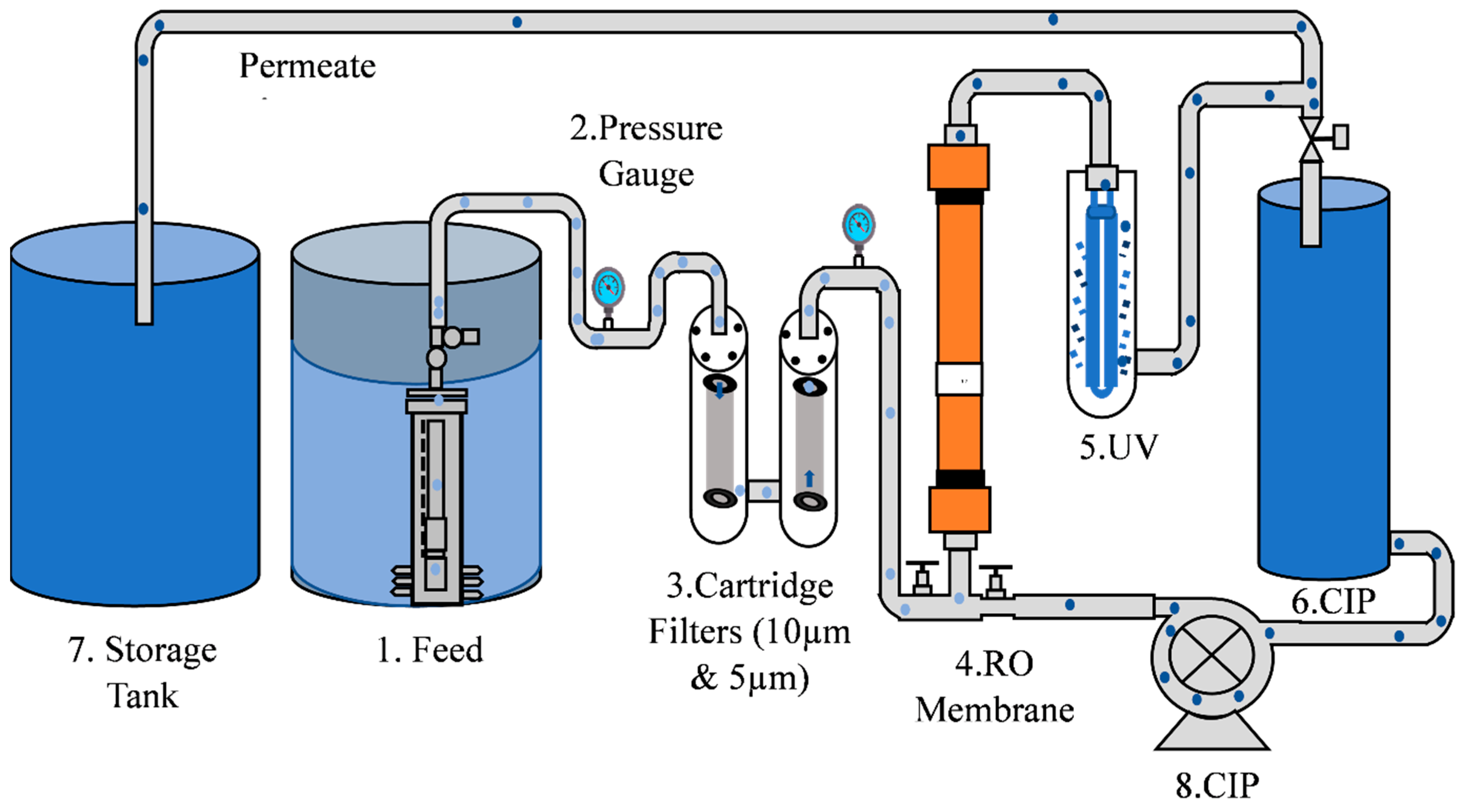
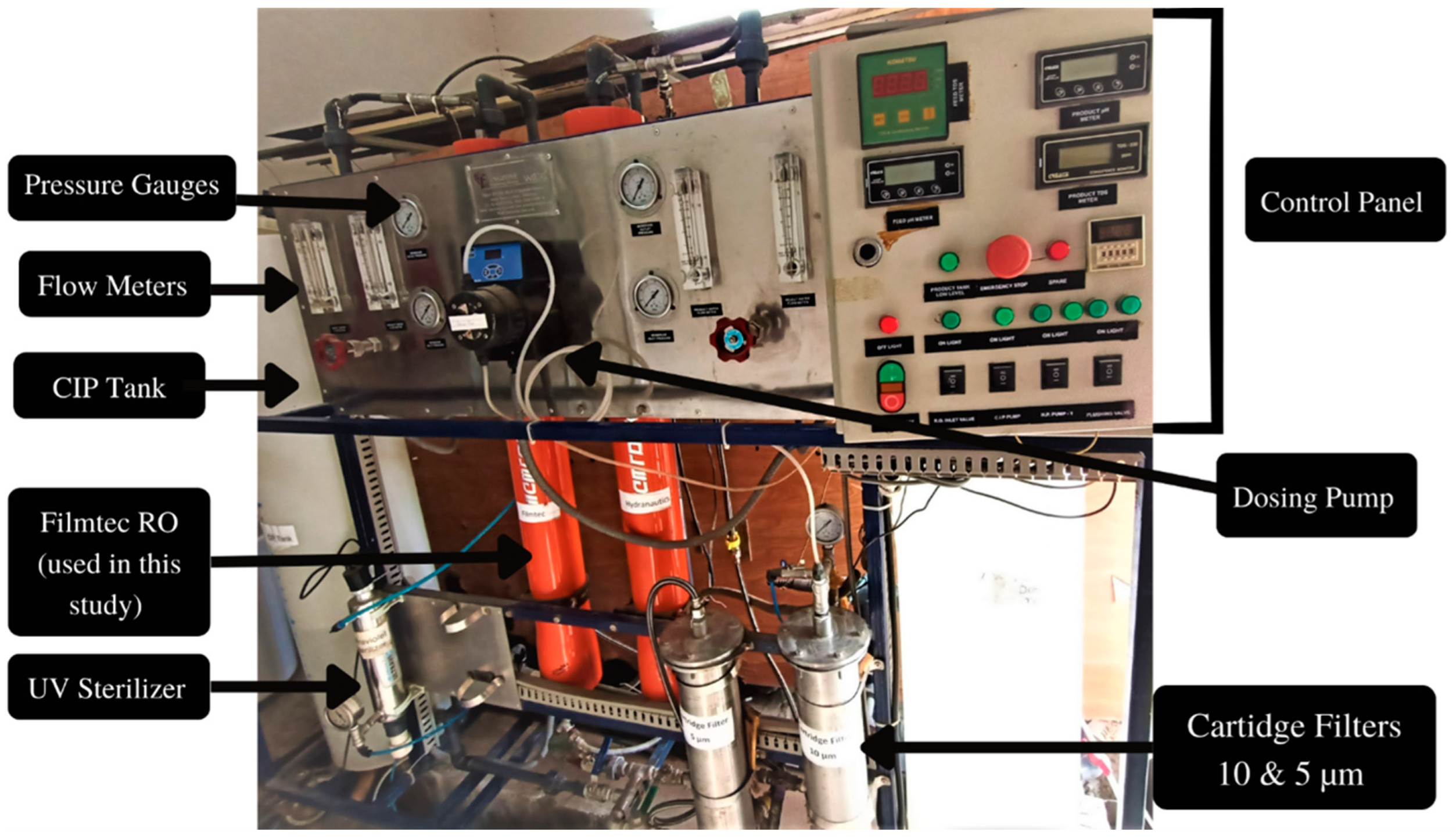

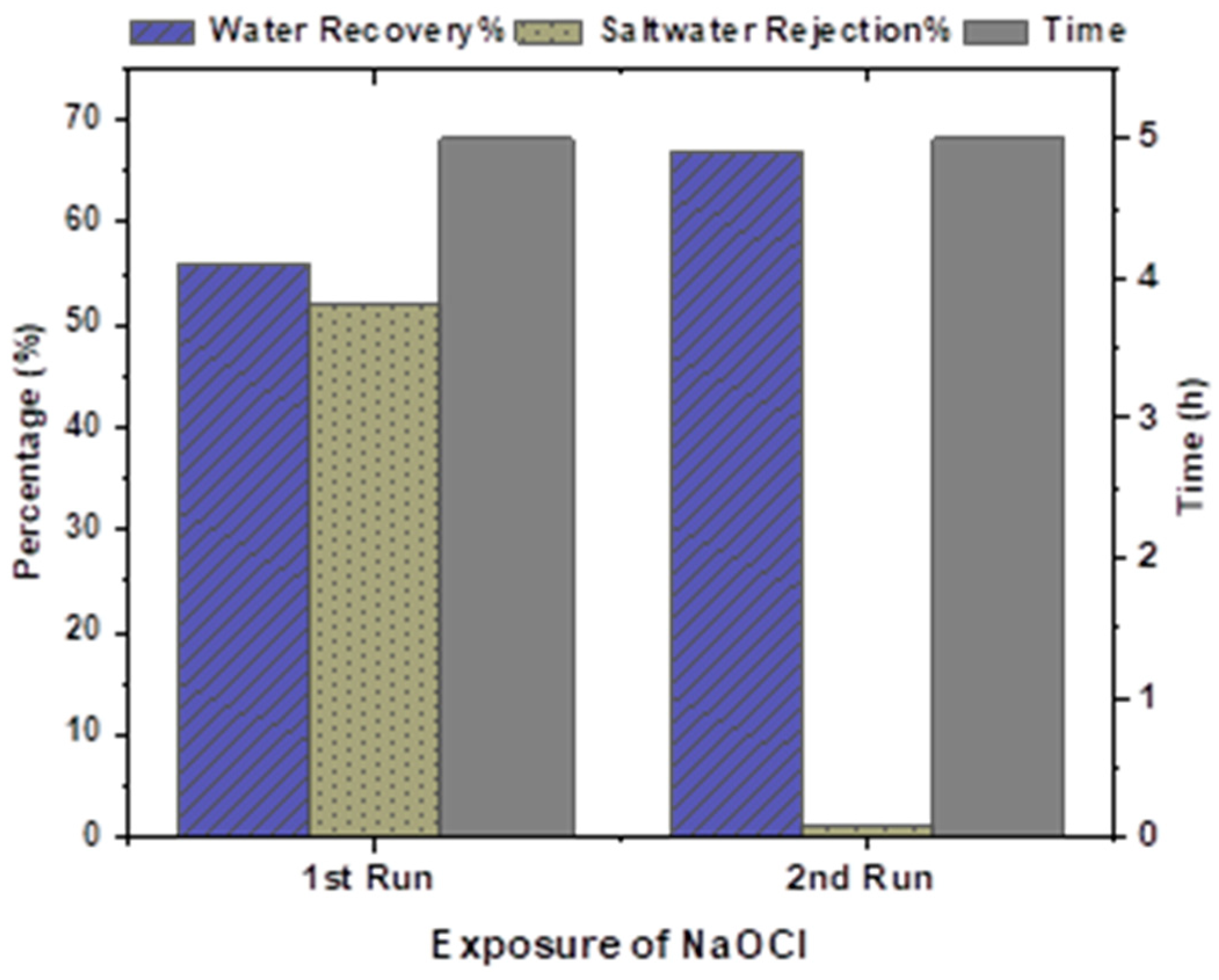
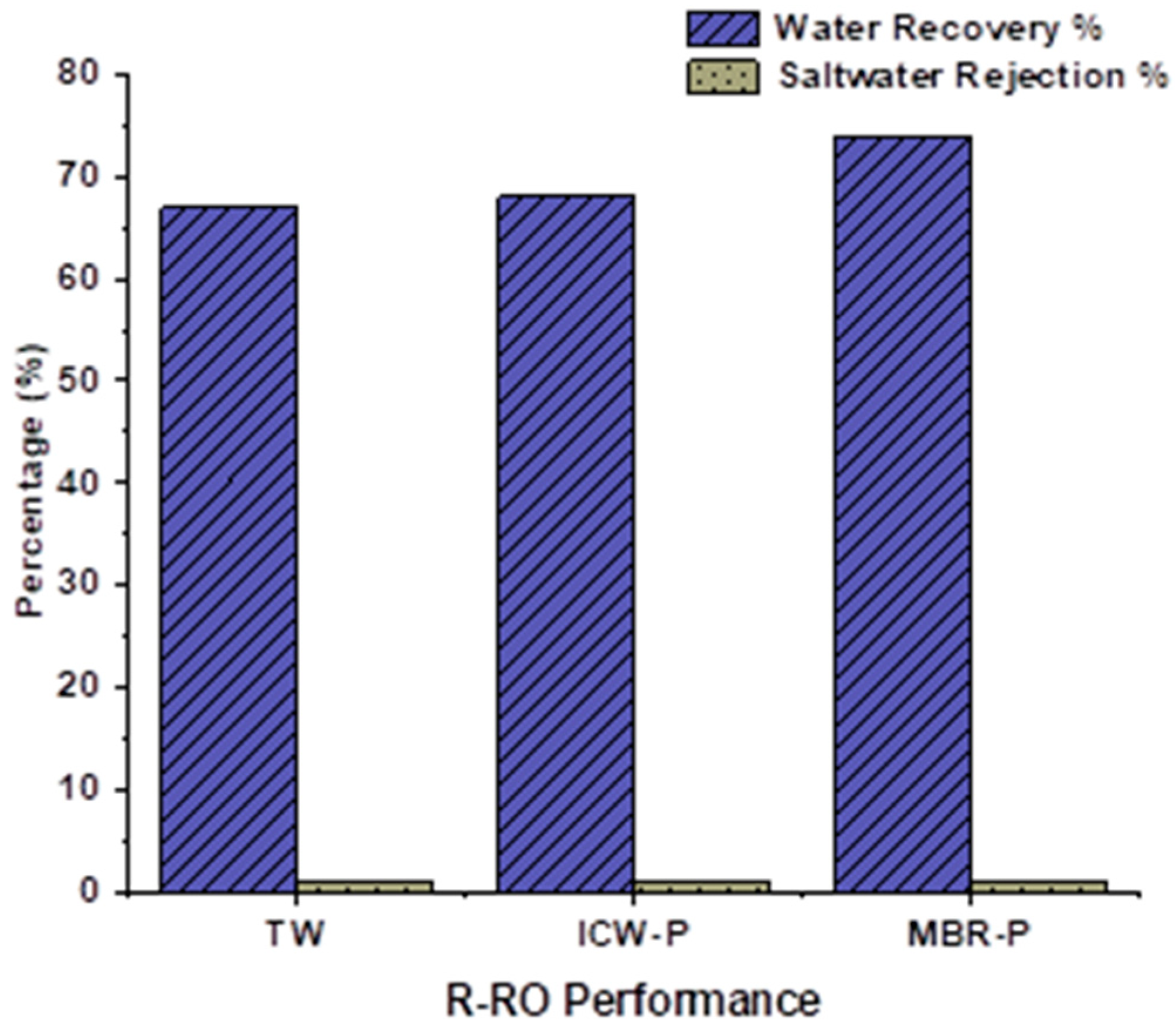



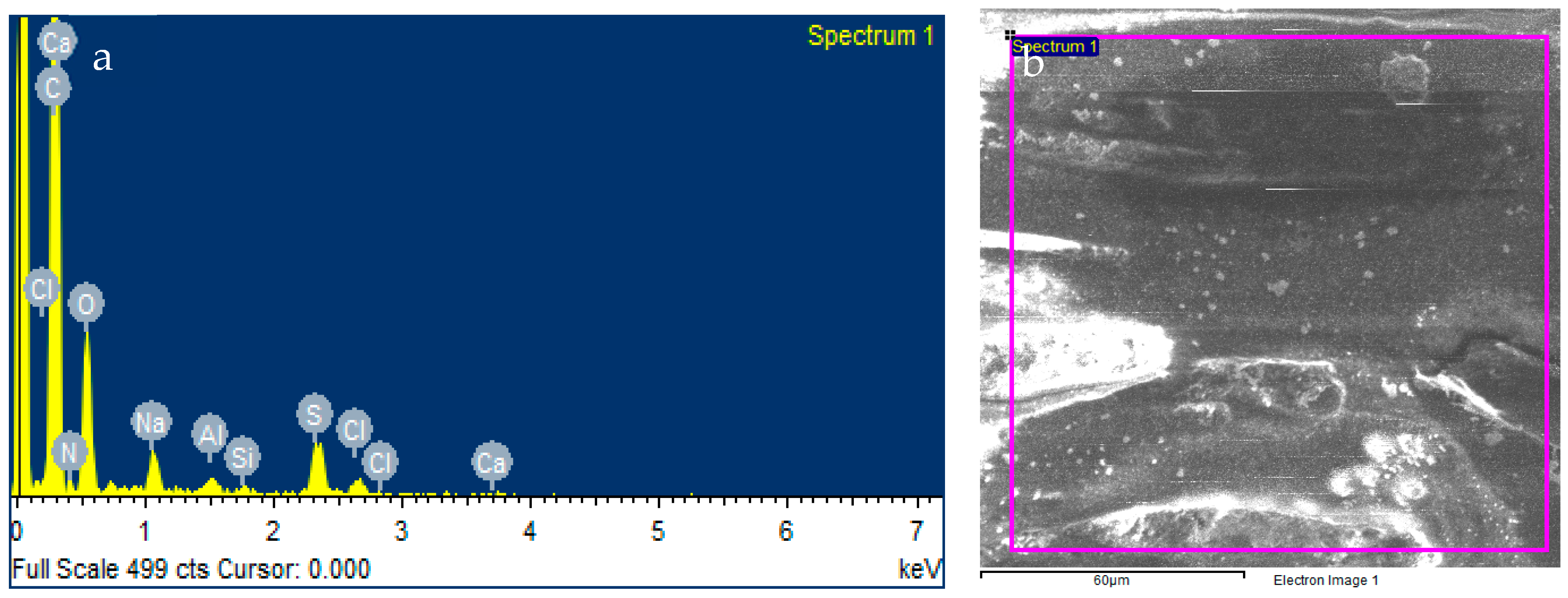
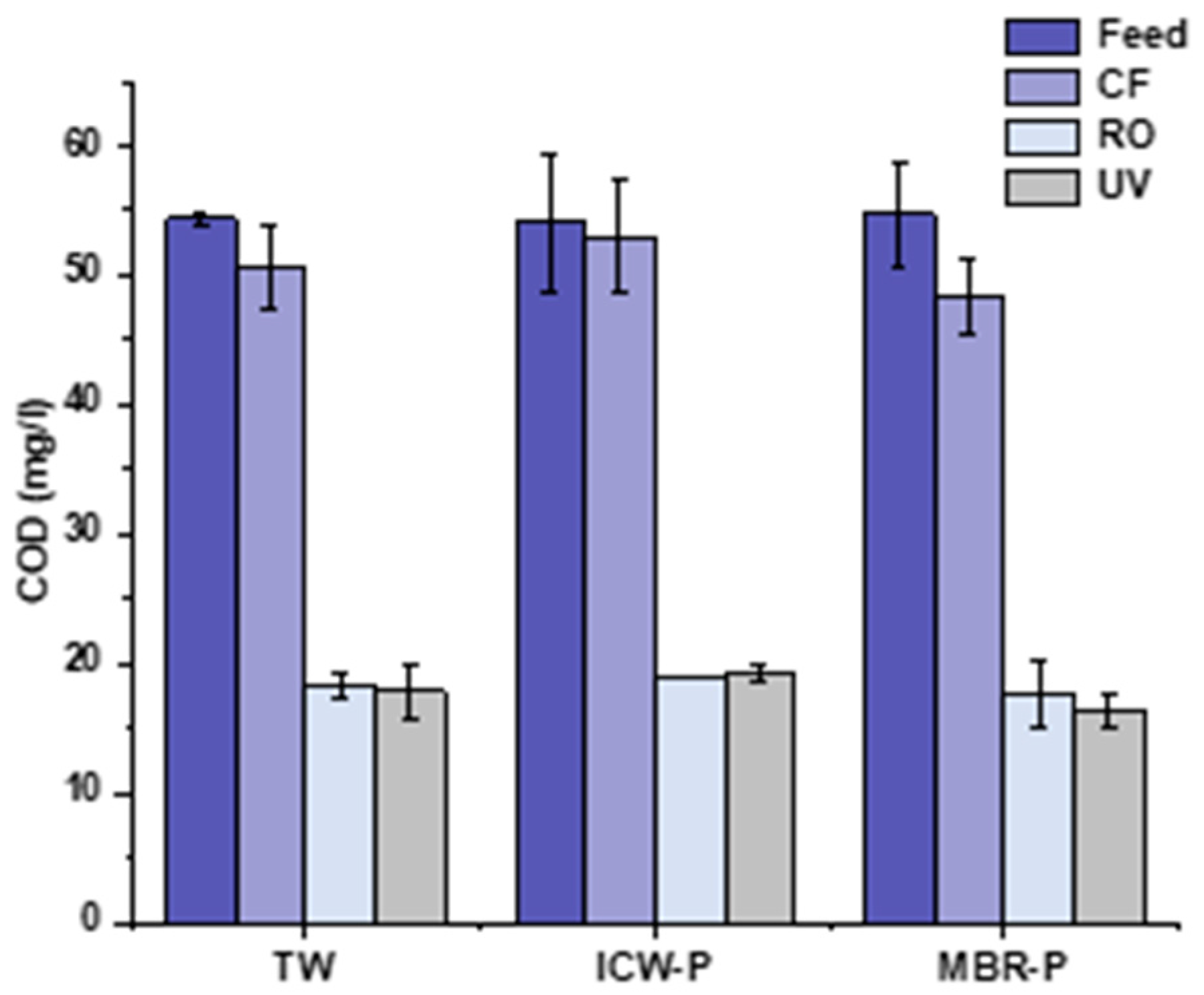
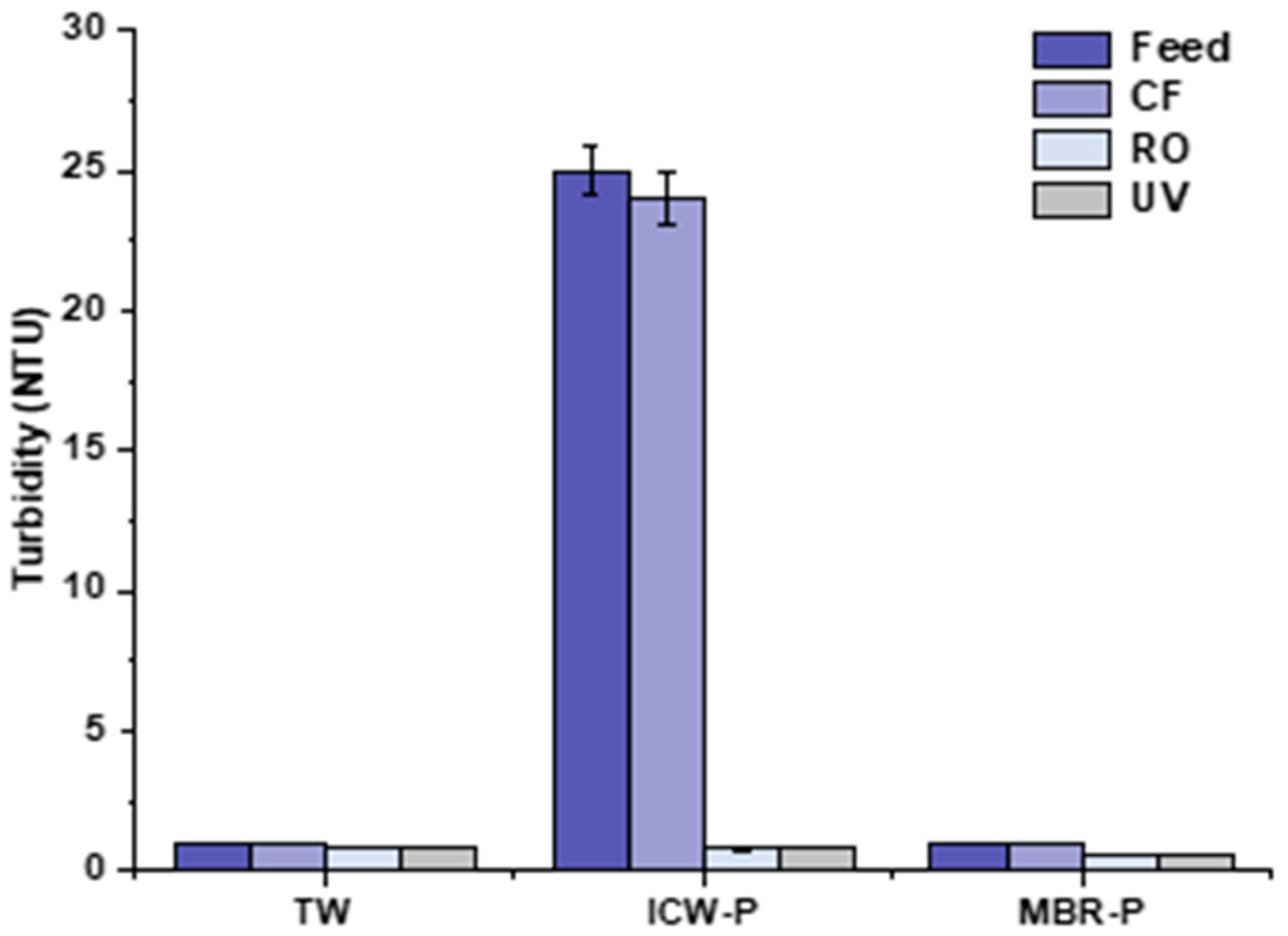
| Membrane | Model | Size (Inches) | Active Area ft2 (m2) | Maximum Operating Pressure | Maximum Operating Temperature | pH |
|---|---|---|---|---|---|---|
| Filmtec-BWRO | LC-LE-4040 | 40 | 94 (8.7) | (41 bars) 600 psig | 113 °F (45 °C) | 2–11 |
| Runs | Membrane | Chemical Used | Exposure Time (h) | Method (AS or PS) | Dose Level (ppm/h) | Total Exposure Time (h) |
|---|---|---|---|---|---|---|
| 2 | Filmtec- BWRO (LC-LE-4040) | 6% NaOCl (12.5% conc. aqueous solution) | 5 h | Active System (CIP pump used) | 300,000 | 5 |
| Water Type | |||
|---|---|---|---|
| Parameters | TW | ICW-P | MBR-P |
| pH | 7 | 8 | 8 |
| EC (uS/cm) | 1047 | 1614 | 1143 |
| Turbidity (NTU) | 1 | 25 | 1 |
| COD (mg/L) | 49 | 53 | 55 |
| MPN (CFU/100 mL) | >23 | >23 | >23 |
| Element | Weight % | Atomic % |
|---|---|---|
| C K | 38.21 | 43.51 |
| N K | 37.24 | 36.36 |
| O K | 22.21 | 18.99 |
| Na K | 0.87 | 0.52 |
| Al K | 0.19 | 0.10 |
| Si K | 0.07 | 0.03 |
| S K | 0.85 | 0.36 |
| Cl K | 0.33 | 0.13 |
| Ca K | 0.02 | 0.01 |
| 100.00 |
| Intermittent Stages | ||||
|---|---|---|---|---|
| TW, ICW-P and MBR-P | Feed | CF | Recycled RO | UV |
| MPN (CFU/100 mL) | >23 | >23 | 0 | 0 |
| 95% Confidence Limits | 13 | 13 | 1–3.4 | 1–3.4 |
| Removal % | 100% | 100% | ||
| Water Type | Standards Limits | |||||
|---|---|---|---|---|---|---|
| Parameters | TW | ICW-P | MBR-P | WHO Standards | NSDWQ Pakistan | NEQS for Municipal and Liquid Industrial Effluent |
| pH | 7 | 7.3 | 7.8 | 6.5–8.5 | 6.5–8.5 | 6–9 |
| EC (uS/cm) | 1035 | 1602 | 1143 | |||
| Turbidity (NTU) | 0.8 | 0.8 | 0.6 | <5 NTU | <5 NTU | |
| COD (mg/L) | 49 | 53 | 55 | 150 mg/L | ||
| MPN (CFU/100 mL) | Not detected | Not detected | Not detected | Must not be detectable in 100 mL of water | Must not be detectable in 100 mL of water | |
| Nitrate (mg/L) | 0.733 | 3.02 | 2.31 | 50 mg/L | ≤50 mg/L | |
Disclaimer/Publisher’s Note: The statements, opinions and data contained in all publications are solely those of the individual author(s) and contributor(s) and not of MDPI and/or the editor(s). MDPI and/or the editor(s) disclaim responsibility for any injury to people or property resulting from any ideas, methods, instructions or products referred to in the content. |
© 2023 by the authors. Licensee MDPI, Basel, Switzerland. This article is an open access article distributed under the terms and conditions of the Creative Commons Attribution (CC BY) license (https://creativecommons.org/licenses/by/4.0/).
Share and Cite
Rehman, Z.U.; Amjad, H.; Khan, S.J.; Yasmeen, M.; Khan, A.A.; Khanzada, N.K. Performance Evaluation of UF Membranes Derived from Recycled RO Membrane, a Step towards Circular Economy in Desalination. Membranes 2023, 13, 628. https://doi.org/10.3390/membranes13070628
Rehman ZU, Amjad H, Khan SJ, Yasmeen M, Khan AA, Khanzada NK. Performance Evaluation of UF Membranes Derived from Recycled RO Membrane, a Step towards Circular Economy in Desalination. Membranes. 2023; 13(7):628. https://doi.org/10.3390/membranes13070628
Chicago/Turabian StyleRehman, Zia Ur, Hira Amjad, Sher Jamal Khan, Maria Yasmeen, Aftab Ahmad Khan, and Noman Khalid Khanzada. 2023. "Performance Evaluation of UF Membranes Derived from Recycled RO Membrane, a Step towards Circular Economy in Desalination" Membranes 13, no. 7: 628. https://doi.org/10.3390/membranes13070628
APA StyleRehman, Z. U., Amjad, H., Khan, S. J., Yasmeen, M., Khan, A. A., & Khanzada, N. K. (2023). Performance Evaluation of UF Membranes Derived from Recycled RO Membrane, a Step towards Circular Economy in Desalination. Membranes, 13(7), 628. https://doi.org/10.3390/membranes13070628











